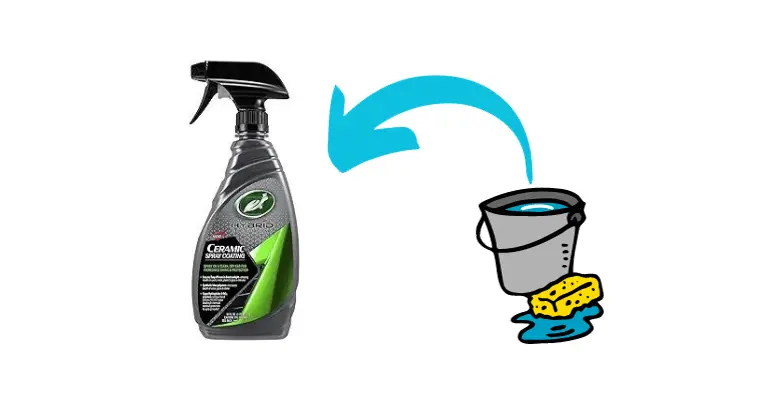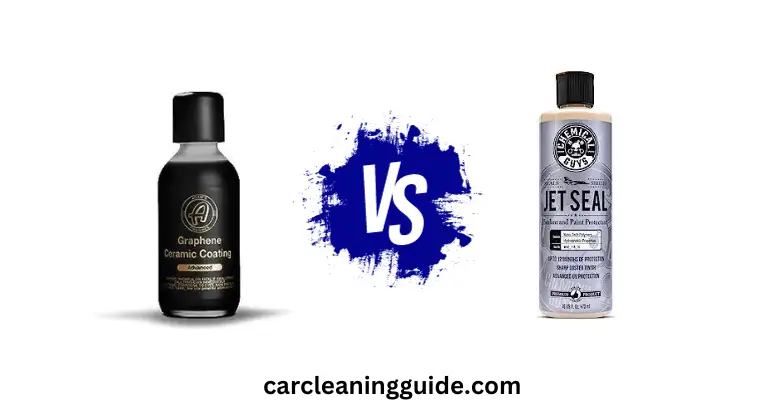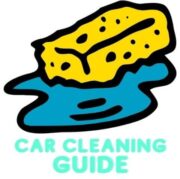Last Updated on November 14, 2023 by Chase Manhattan
In recent years, ceramic car coatings have emerged as a superior alternative to traditional car waxes. While many believe that applying a ceramic coating requires professional expertise, the reality is that with the right products and techniques, anyone can achieve a professional finish at home. Let’s delve into the step-by-step process of preparing and applying ceramic wax to your vehicle.
- How to Clean Car Carpets Quick and Easy - July 10, 2024
- Can You Touch Up Clear Coat? Yes and No (Here’s Why) - November 25, 2023
- How To Wax A Car By Hand: A Comprehensive Guide - November 14, 2023
Quick Navigation
What’s The Deal With Ceramic Coatings?
Ceramic coatings have been around for over two decades, offering a more durable and long-lasting protection compared to traditional waxes. While professional detailing can be costly and time-consuming, there are DIY products available that provide similar results without the hefty price tag. For instance, products from Turtle Wax’s Hybrid Solutions Ceramic line are user-friendly and promise up to 12 months of paint protection.
Benefits of Ceramic Wax:
- Protection from Environmental Hazards: Ceramic wax offers a shield against harmful UV rays, acid rain, bird droppings, and other environmental contaminants.
- Long-lasting Shine: Ceramic wax provides a radiant shine that lasts for months.
- Hydrophobic Properties: Raindrops and water splashes bead up and roll off the surface, reducing water spots and stains.
- Cost-Effective: Fewer reapplications mean savings in both time and money.

Read more: Benefits of Waxing Your Car
The Importance of Preparation
Achieving the desired shine, protection, and hydrophobic properties from your ceramic coating largely depends on proper preparation. Before diving into the application process, it’s crucial to ensure that your car’s surface is impeccably clean and free from contaminants.
Steps to Prepare Your Car for Ceramic Wax:
- Wash and Dry the Car: Rinse your vehicle from top to bottom, scrub off any dirt or grime, and dry using a microfiber towel or a leaf blower.
- Detect and Remove Embedded Contaminants: Slide your hand across the car’s surface inside a plastic bag. If you feel roughness, use synthetic detailing clay to remove these contaminants.
- Correct the Paint: For light scratches, a product like Hybrid Solutions Ceramic Polish & Wax can be beneficial. For deeper imperfections, consider using dedicated products before wax application.
Related article: How To Clay Bar A Car To Remove Embedded Dirt
Step-By-Step Guide to Ceramic Waxing Your Car:
- Ensure Proper Lighting: Work in a well-lit area or garage to ensure you don’t miss any spots during the application.
- Apply Ceramic Wax: Using a foam applicator pad, apply a small amount of ceramic wax onto the pad.
- Work in Sections: Start from the top of the car and work your way down, applying the wax in 2′ x 2′ sections.
- Use Circular Motions: Gently rub the wax onto the car’s surface using circular motions, ensuring even coverage.
- Allow to Haze: After applying, wait for the wax to haze. This usually takes a few minutes, but refer to the product’s instructions for specific times.
- Buff Off: Once hazed, use a clean microfiber towel to buff off the wax, revealing a shiny surface.
- Inspect Your Work: Check for any missed spots or areas where the wax might not have been buffed off properly.
- Cure Time: Allow the wax to cure for the time specified in the product’s instructions, typically 24 hours, during which you should avoid getting the car wet.
Related article: How Long Does Ceramic Coating Take To Cure?
If you prefer a visual demonstration, check out this video below:
Post-Application Care:
- Regular Washing: Wash your car every two weeks using a pH-balanced car shampoo.
- Avoid Harsh Chemicals: Steer clear of abrasive cleaning agents.
- Reapplication: Depending on the product and environment, reapply ceramic wax every 6-12 months.
Read more: How To Maintain A Ceramic Coating
How Frequently Should Ceramic Wax Be Re-Applied?
The frequency of reapplication largely depends on the specific product used and the environmental conditions your car is exposed to. Generally, ceramic waxes last longer than traditional waxes, with many products promising protection for up to 12 months. However, for optimal results and continuous protection, it’s recommended to reapply ceramic wax every 6 to 12 months.
Related: How Many Layers of Ceramic Coating Is Best for Longevity?
Common Mistakes to Avoid:
- Applying in Direct Sunlight: This can cause the product to dry too quickly, leading to streaks.
- Not Cleaning the Car Properly: Dirt or contaminants left on the car can get sealed under the wax.
- Using Too Much Product: A little goes a long way.
Keep reading here: How to Protect Car Paint
Comparisons with Other Products:
- Traditional Waxes: Offer shine and protection but typically don’t last as long as ceramic waxes.
- Sealants: Longer protection than traditional waxes but might not provide the same depth of shine.
- Ceramic Coatings: A more permanent solution that offers superior protection but often requires professional installation.

Related articles:
> Ceramic Coat vs Wax
> Paint Sealant vs Ceramic Coating
> Paint Sealant vs Wax
By following the steps and tips outlined above, you can ensure that your car remains protected, shiny, and looking its best for months to come. Whether you’re a DIY enthusiast or someone looking to save on professional detailing costs, applying ceramic wax at home is a feasible and rewarding endeavor. Happy detailing!
FAQs
What makes ceramic wax different from traditional waxes?
Ceramic wax is a fusion of traditional car wax and ceramic compounds. While traditional waxes provide a temporary shine and protection, ceramic waxes offer a more durable and long-lasting shield against environmental contaminants. The ceramic components in the wax bond more effectively with the car’s paint, resulting in a harder, more resilient protective layer.
Can I apply ceramic wax on a car with scratches or imperfections?
While ceramic wax can be applied to a car with minor imperfections, it’s best to correct any significant scratches, swirls, or oxidation before application. Ceramic wax will seal the surface, and any underlying imperfections might become more noticeable once the wax is applied. For the best results, always start with a clean, well-prepared surface.
Is there a specific technique for applying ceramic wax?
The application technique can vary based on the product, but generally, it’s recommended to work in small sections using circular motions. This ensures even coverage and reduces the chances of streaking. After application, allow the wax to haze before buffing it off with a microfiber towel.
Can ceramic wax be used on other surfaces besides paint?
Most ceramic waxes are formulated specifically for car paint. However, some products might be safe for use on glass, chrome, and plastic trim. Always refer to the product’s label or manufacturer’s guidelines to determine its suitability for different surfaces.
Food for thought: Should You Wax New Cars? Here’s What To Know

